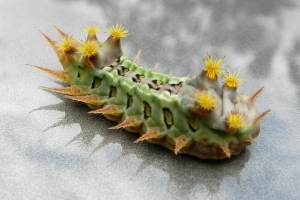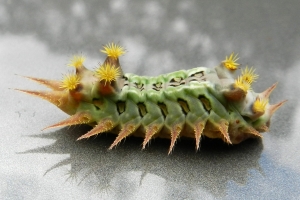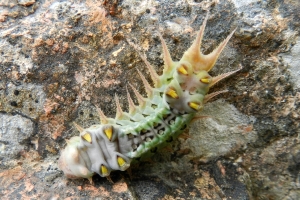

 +2Kontinente:EUOC
+2Kontinente:EUOC2. Biologie
2.1. Nahrung der Raupe
- [Myrtaceae:] Eucalytus sp. (Eukalyptus, Blaugummibaum)
Schon Newman (1855) berichtete, dass die Raupen an Eucalyptus leben. Er formuliert: "The cocoon of B. Oxleyi is remarkably small for the size of the moth, being scarcely larger than a good-sized pea: it is of an oval shape, extremely compact, and not to be broken without a sharp blow; it is com- posed of a glutinous substance secreted by the larva, and mingled with highly comminuted particles of the rind of a twig of some species of Eucalyptus, to the denuded wood of which it is firmly attached, the caterpillar evidently laying bare a portion of the twig with its mandibles and employing the fragments in the fabrication of its cocoon, the smaller end of which is provided with an operculum or lid, which separates only on the imago arriving at maturity, and leaves a smooth- margined, perfectly circular aperture, through which the moth escapes."
3. Weitere Informationen
3.1. Etymologie (Namenserklärung)
Newman (1855) teilte mit: "I am indebted to Mr. Oxley for the opportunity of describing both the moth and the cocoon, and have much pleasure in dedicating the species to that zealous entomologist."
3.2. Andere Kombinationen
- Bombyx (Doratifera?) oxleyi Newman, 1855 [Originalkombination]
- Pelora oxlei (Newman, 1855)
- Doratifera oxlei (Newman, 1855)
3.3. Taxonomie
Newman (1855: ccxii) war sich mit der Zuordnung zu Doratifera keineswegs sicher: "I do not find any characters of the genus Doratifera".
3.4. Faunistik
Die Art wurde aus Australien beschrieben, wo sie für New South Wales, Victoria, Süd-Australien und Tasmanien genannt wird. Walker (1855) führt für seine "Pelora oxlei" Sidney und "New Hollad" an, letzteres nur ein alter Name für Australien.
Details zur Meldung aus den Niederlanden (oder war doch nur "New Holland" falsch interpretiert worden?) sind mir noch nicht bekannt.
(Autor: Erwin Rennwald)
3.5. Literatur
- Erstbeschreibung: Newman, E. (1855): Art. XXXII.-Characters and some Account of the Economy of a supposed new Species of Australian Bombyx. — The Zoologist, 13: Appendix: ccxi-ccxii. [Digitalisat auf archive.org]
- Beschreibung als Pelora oxlei: Walker, F. (1855): List of the Specimens of Lepidopterous Insects in the Collection of the British Museum 5: 977-1257. [Digitalisat auf archive.org]







